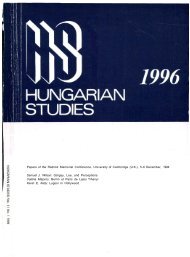The Canadian-American Review of Hungarian Studies - Vol. 4 ... - EPA
The Canadian-American Review of Hungarian Studies - Vol. 4 ... - EPA
The Canadian-American Review of Hungarian Studies - Vol. 4 ... - EPA
Create successful ePaper yourself
Turn your PDF publications into a flip-book with our unique Google optimized e-Paper software.
attitudes to immigrant minority cultures. This change could be achievedonly with the help <strong>of</strong> civic and educational institutions:Our national holidays might well be given over to such pageantry(including, perhaps festivals <strong>of</strong> drama, poetry, and music) as wouldemphasize the co-operative existence <strong>of</strong> the distinct racial groups in ourpopulation. Our schools might give ample recognition to their historyand culture. Our universities might foster their languages and literatures.. . 22He also believed that the state had a responsibility in preserving the "fullpotentialities <strong>of</strong> our several peoples." 23 In expressing this view, Kirkconnellanticipated by some four decades the concept <strong>of</strong> governmentsupportedmulticultural programmes.<strong>The</strong> <strong>Hungarian</strong>s <strong>of</strong> WinnipegBy the time Kirkconnell developed these basic ideas about ethnicnativerelations and a multicultural <strong>Canadian</strong> identity, he was inincreasingly close contact with the <strong>Hungarian</strong> community in Canada,particularly with the growing and important <strong>Hungarian</strong> colony inWinnipeg. During the 1920"s Winnipeg, that growing, polyglot prairiemetropolis, was the largest centre <strong>of</strong> Canada's "new immigration". Itwas here that the masses <strong>of</strong> freshly arrived immigrants rested beforesetting out for their homesteads on the edge <strong>of</strong> Canada's ever expandingfrontier <strong>of</strong> agricultural settlement. But while the newcomers weremoving toward the fringes <strong>of</strong> the prairies, other immigrants weremaking their way to the city: disappointed farmers, labourers, craftsmenand merchants who had somehow entered Canada despite Ottawa'srestrictions on non-agricultural immigrants.By the time Kirkconnell's pr<strong>of</strong>essional career had begun, Winnipegwas the busiest urban centre for Canada's <strong>Hungarian</strong> community.Magyar immigrants had started to settle in the city at the turn <strong>of</strong> thecentury. During the next two decades their numbers increased. By themid-1920's they had a few organizations <strong>of</strong> their own, including aPresbyterian congregation, a Roman Catholic parish, and a sick-benefitinsurance society. Other clubs, serving social and recreational purposes,would spring up a few years later. This community soon became one <strong>of</strong>the most influential in Canada and produced what may be calledCanada's <strong>Hungarian</strong> elite. Steamship and railway ticket agents, priestsand ministers as well as other members <strong>of</strong> the very small New <strong>Canadian</strong>middle class frequented the city and settled there as circumstancespermitted. Even more important, from the point <strong>of</strong> view <strong>of</strong> the Hun-
















